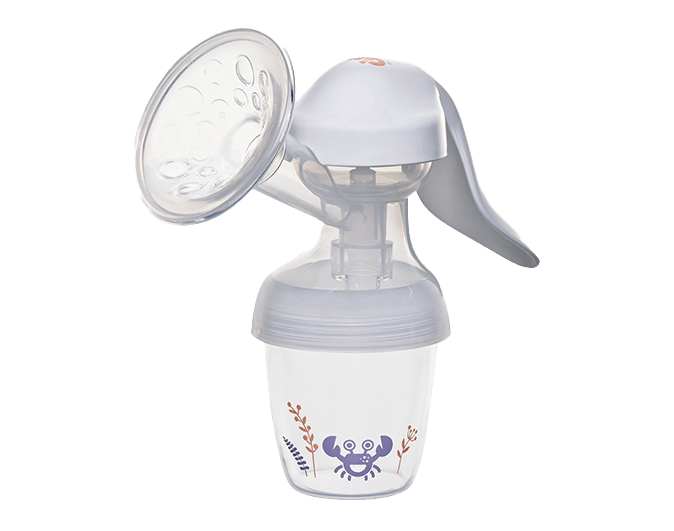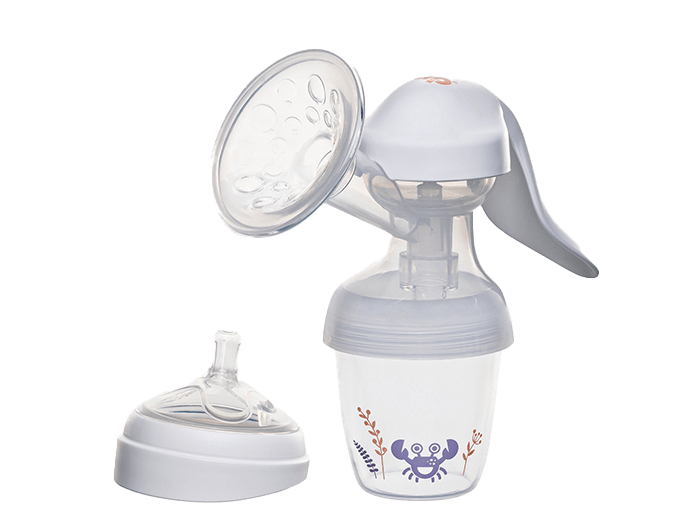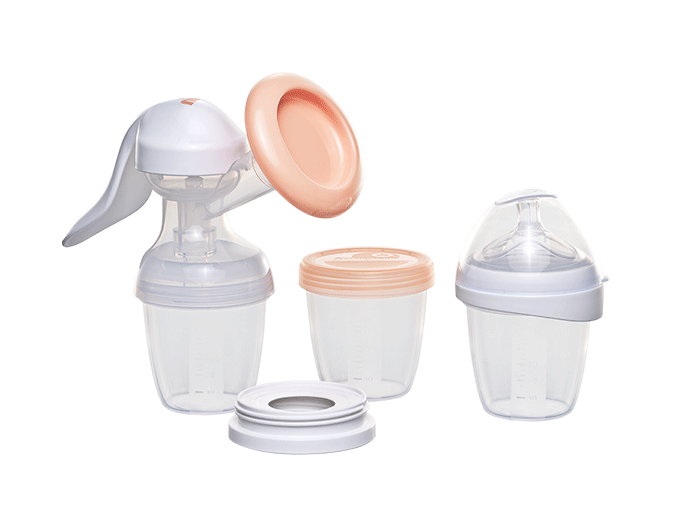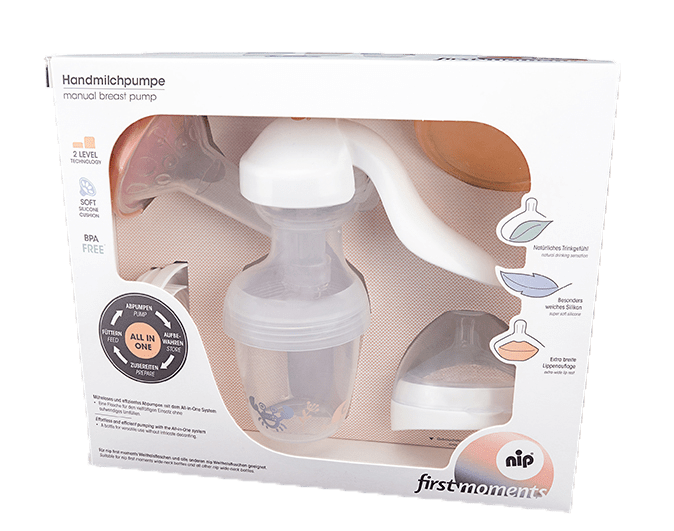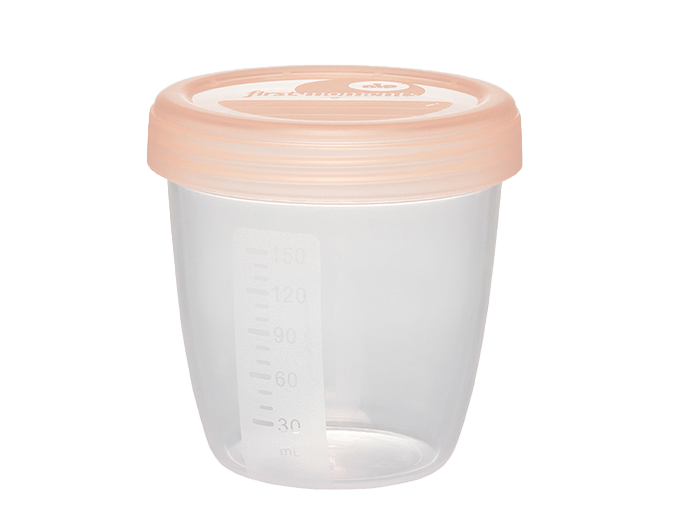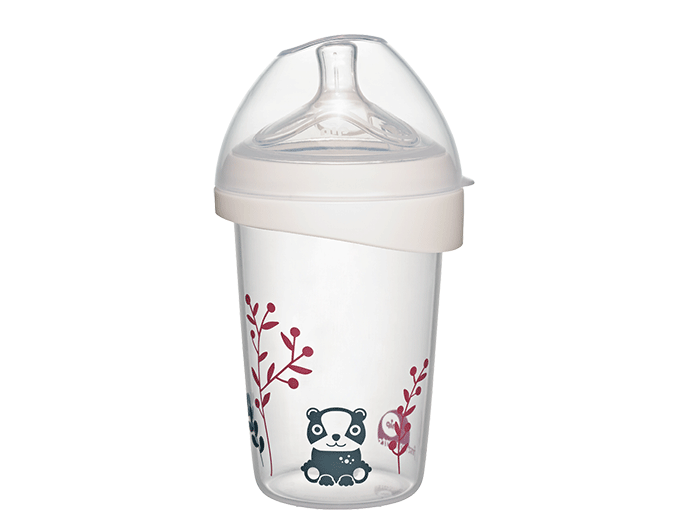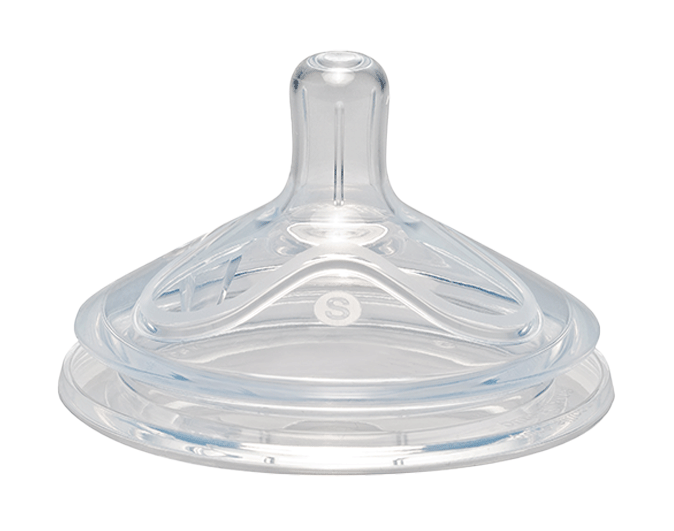
Breastfeeding
first moments manual breast pump
- manual breast pump with two different pumping levels (2-stage technology)
- extra soft silicone pad
- container can be used directly for freezing or feeding
- without time-consuming decanting
- with additional adapter for other nip® wide-neck bottles
- easy to assemble and clean
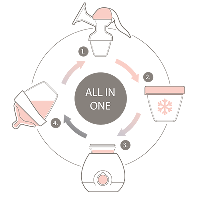
Our All-in-One system: so easy and comfortable
The All-in-One system makes it easier to pump, store, prepare and feed breast milk than ever before. Everything using just one bottle, without the need to transfer contents again and again. And without an adapter.

2 Level Technology
Every woman has different preferences. That‘s why our first moments manual breast pump has two different pumping levels (2 Level Technology). Level 1 for weaker pumping performance and stimulation. Level 2 for a stronger pumping performance. The pumping level can be selected quickly and easily by changing the pump piston. Just the way it feels right for you.
Extra soft silicone cushion
Our manual breast pump has an extra soft silicone cushion that gently soft to your skin for especially gentle pumping of breastmilk. Thanks to the ergonomically shaped handle, the manual breast pump also feels very comfortable in the hand.
Easy cleaning
The first moments manual breast pump consists of very few parts, making it especially easy to assemble and clean. All parts of the manual breast pump, with the exception of the silicone cushion, can be cleaned quickly and easily in the dishwasher.
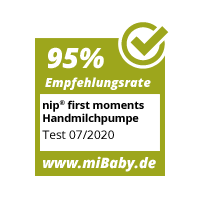
Product test at MiBaby
"What are the criteria for a good manual breastpump? It must fit well in the hand, not be too complicated to use and easy to clean.
In all these points, the hand breast pump from nip® first moments is convincing all along the line! More than 89% of mothers stated that the pump fits well in the hand and 91% rated the selection of the two pump stages as good or even very good." Test result
Material
Material: PP, silicone from BPA free raw materials (according to the law)
Extra soft silicone cushion
... the pumping attachment of the manual breast pump has extra soft silicone, which gently nestles against your sensitive skin and enables gentle pumping
Ergonomically shaped handle
... the handle fits comfortably in your hand thanks to its ergonomic design. It increases the ease of use of the hand breast pump and thus makes it easier for you to pump breast milk
Dishwasher safe
... apart from the silicone parts, all parts can be cleaned in the dishwasher
How can I ensure a good start in the breastfeeding relationship?
You should choose a quiet environment in which you feel comfortable, especially at the beginning of the breastfeeding relationship. You should avoid sources that disturb you such as noise and incorrect lighting. Especially in the beginning, your breastfeeding relationship needs a lot of patience. Make sure you choose a position that is comfortable for you.
Once you have found a comfortable position, you should pay attention to the following things:
*Your baby should open his or her mouth as wide as possible when latching onto the breast.
*Your baby's belly should be against your belly.
*Make sure your baby puts as much of the nipple in his or her mouth as possible.
*You should be able to watch your baby's puckered lips as he or she feeds.
Watch for signs of hunger from your baby. At first, your baby will only bring his hands to his mouth and may try to suck on them. Your baby's movements will become more and more frantic and faster until he or she starts to cry.
Try to put your baby on in the early stages, when he is not too nervous.
Put your baby on as needed until he stops sucking on the breast.
How often should my baby drink at the breast?
It takes a little patience for the breastfeeding rhythm to settle between you and your baby.
In the first few days, you should feed your baby at least every 3 to 4 hours. To stimulate milk production, you should put your baby to the breast as often as possible during this sensitive initial phase. After 4 hours at the latest, you should wake your baby for breastfeeding. You can do this, for example, by undressing the baby. During your baby's growth spurts, the breastfeeding intervals may be shorter for a few days. The shorter breastfeeding intervals are your baby's way of showing your body that it needs to produce more milk.
During breastfeeding, it is very important that you as a mother also pay attention to sufficient calorie intake and fluid intake.
How can I tell if meion baby is getting enough breast milk?
Since it is not possible to measure the exact amount that the baby drinks, many parents are unsure at the beginning whether the milk is in sufficient quantity.
Yet there are clues that will show you that the baby is getting enough breast milk:
Excretion
After milk let-down (around the third/fourth day), your baby should have 5 to 6 wet diapers in 24 hours.
Weight gain
It is perfectly normal for your baby to lose up to 7% of his or her birth weight after birth. Your baby should regain his or her birth weight by the 14th day of life. The weekly weight gain for a healthy and mature baby should be at least 150 grams.
The breast feels empty after breastfeeding
You should let your baby drink for at least 15 minutes per side. In doing so, it will drink the first breast empty much more forcefully than the second breast. In order to have a sufficient stimulation of milk production, you should follow the following rule:
1. if your baby only manages to drink from one breast, apply to the other breast on the next pass.
2. if your baby feeds from both breasts, you should start again from the last side. Since the breastfeeding process is strenuous for your baby, he will not be able to drink as much at the second breast as he did at the first breast.
Your baby seems satisfied after breastfeeding
When your baby's hunger slowly decreases, you can observe how he or she enters a state of relaxation again. Babies often fall asleep after drinking enough at the breast. Make sure that the baby has sucked sufficiently beforehand.
Audible swallowing during breastfeeding
Don't be surprised if your baby takes short pauses during the sucking process. Your baby needs these pauses to swallow the milk that has accumulated in the mouth during sucking. Your baby swallows after every 1-2 suckings. Swallowing will decrease during the breastfeeding process with the duration of breastfeeding.
What if breastfeeding doesn't work out for a variety of reasons?
Breastfeeding cones:
Nursing caps are available in different sizes. It is important to choose the right size at the beginning. When you have triggered the milk-giving reflex by hand or with the pump, spread a little breast milk around the nipple. This will help the nursing cap to adhere to the skin.
Now you can apply the nursing cap to the breast as follows:
Pull the edges of the nursing cap outwards and place it in the middle of the nipple. When you have put the cap on, let go of the edges, which are now resting on the skin. The vacuum that is now created should cause the cap to hold onto the nipple. The nipple should be centered in the nursing cap. Make sure that the positioned nipple does not touch the funnel of the nursing cap. If this is the case, your nursing cap is too small.
Once the cap is in place, make sure that your baby is latched onto the breast correctly. It is important that your baby not only sucks on the cap, but that as much of the nipple as possible is in his mouth while sucking.
After breastfeeding, you should ensure good hygiene and thorough cleaning of the nursing cap.
Spread any residual milk from the nipple onto the nipple and allow it to dry. This will help you heal irritated nipples.
Pumping:
If your baby is not drinking well at the breast for a variety of reasons, or is not yet able to drink at the breast at all, you should stimulate milk production by pumping with a breast pump.
It is important to pump for 15 minutes per breast at regular intervals of about 2 to 3 hours.
If you are breastfeeding at the same time as pumping, make sure that you do not pump directly before the breastfeeding meal, but only after breastfeeding. Since the milk-giving reflex is still active during breastfeeding, this is the best way to ensure successful pumping.
If your baby is not near you, it is advisable to watch a picture or video during pumping.
How long can I store breast milk?
If you want to stock up on breast milk, you should pump small amounts of breast milk after breastfeeding, collect it and then freeze it.
Shelf life of breast milk:
Freshly pumped breast milk is
--> at room temperature à 6 to 8 hours durable
--> in the refrigerator (do not store in the door) à 72 hours at 4°C
--> in the freezer/freezer à 6 months at -18°C
Do not thaw frozen milk in the microwave, but at room temperature. It is important to mark the frozen milk with the date of production. So you do not lose the overview.
Information
Thanks to the adapter, the first moments hand breast pump is also compatible with all other nip® wide-neck bottles.
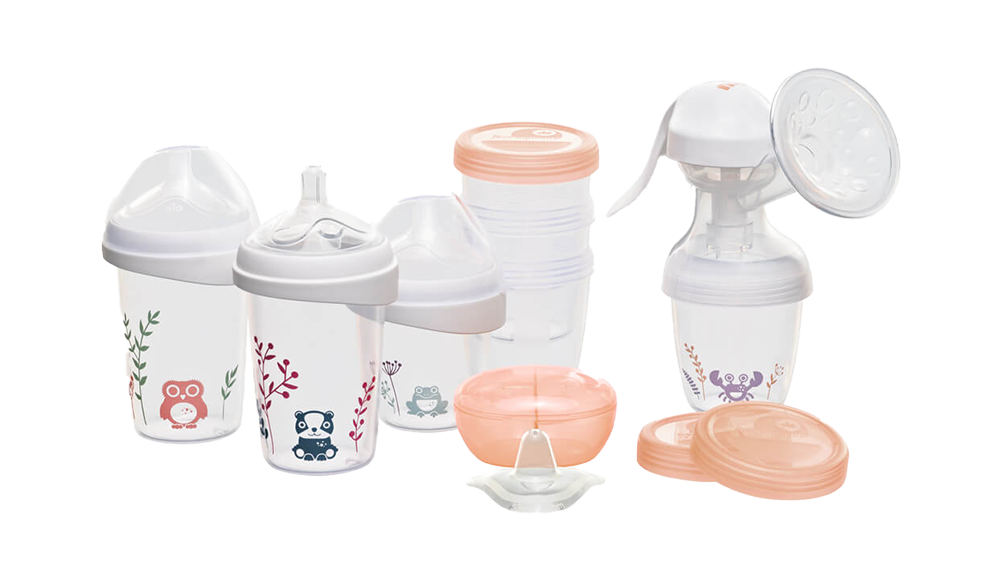
Perfection from passion
For the exciting and loving time after birth, we have developed a range that makes the start into the new life easier for you and your baby and at the same time provides well-being and joy.
Already in its 4th generation and for 90 years, nip has been supporting babies and parents with understanding and experience. Our unique first moments range has been specially developed to support you in the first moments together. For a carefree start. From the very beginning.
More about First moments